Themed collection Horizons Community Board Collection: Biosensors

Horizons Community Board Collection: Biosensors
A themed collection on biosensing, guest edited by Nanoscale Horizons Community Board members Zhiyuan Liu and Arun Richard Chandrasekaran and Materials Horizons Community Board member Gift Mehlana.

Mater. Horiz., 2020,7, 2475-2476
https://doi.org/10.1039/D0MH90062A
About the amplification factors in organic bioelectronic sensors
A systematic comparison between electrochemical and organic bioelectronic sensors reveals a unified rational description for a transistor amplified detection.
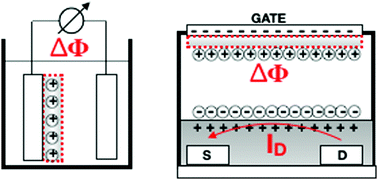
Mater. Horiz., 2020,7, 999-1013
https://doi.org/10.1039/C9MH01544B
Dynamic DNA nanotechnology: toward functional nanoscale devices
This review presents recent advances and continuing challenges in the design, characterization, and modelling of dynamic DNA nanodevices.

Nanoscale Horiz., 2020,5, 182-201
https://doi.org/10.1039/C9NH00529C
Biomimetic nanoparticle technology for cardiovascular disease detection and treatment
Biomimetic nanoparticle technology has the potential to significantly improve the clinical management of cardiovascular disease.
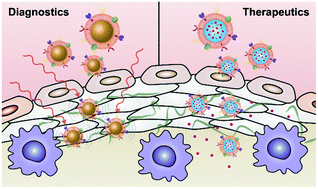
Nanoscale Horiz., 2020,5, 25-42
https://doi.org/10.1039/C9NH00291J
Stimuli-responsive polymers for sensing and actuation
Stimuli-responsive polymers uniquely undergo physical/chemical changes in response to changes in their environment. Here, there use for sensing and actuation is reviewed.
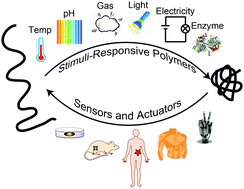
Mater. Horiz., 2019,6, 1774-1793
https://doi.org/10.1039/C9MH00490D
Enzyme-modified electrodes for biosensors and biofuel cells
The use of protein engineering, designer polymers, and the introduction of nanomaterials are key strategies for the design of next-generation bioelectrodes.
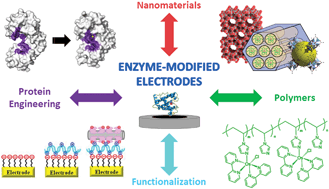
Mater. Horiz., 2019,6, 1336-1358
https://doi.org/10.1039/C9MH00013E
Recent advances in functionalized MnO2 nanosheets for biosensing and biomedicine applications
Schematic illustration of MnO2 nanosheets for applications in biosensing, bioimaging, drug delivery and cancer therapy.
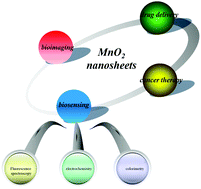
Nanoscale Horiz., 2019,4, 321-338
https://doi.org/10.1039/C8NH00274F
A dual-trigger-mode ionic hydrogel sensor for contact or contactless motion recognition
The sandwiched hydrogel capacitive system is designed to fabricate a dual-trigger mode ionic sensor for recognizing mechanical stimuli and diverse touch-free gestures simultaneously, performing high responsivity and accurate spatial resolution.
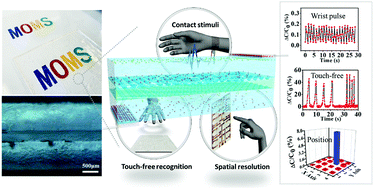
Mater. Horiz., 2020,7, 2673-2682
https://doi.org/10.1039/D0MH00862A
Surface structure engineering for a bionic fiber-based sensor toward linear, tunable, and multifunctional sensing
A bio-segmental structured fiber-based sensor with tailorable strain concentration effect enables tunable sensing properties for multifunctional monitoring applications.
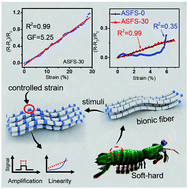
Mater. Horiz., 2020,7, 2450-2459
https://doi.org/10.1039/D0MH00716A
Monitoring supported lipid bilayers with n-type organic electrochemical transistors
An n-type, accumulation mode, microscale organic electrochemical transistor monitors the activity of a pore-forming protein integrated into a lipid bilayer.
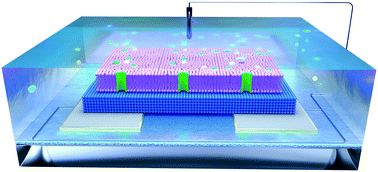
Mater. Horiz., 2020,7, 2348-2358
https://doi.org/10.1039/D0MH00548G
Methylation dependent gold adsorption behaviour identifies cancer derived extracellular vesicular DNA
Methylation dependent gold adsorption behaviour of extracellular vesicular DNA enables liquid biopsy test for cancer.
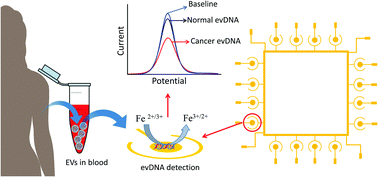
Nanoscale Horiz., 2020,5, 1317-1323
https://doi.org/10.1039/D0NH00258E
Stretchable, self-healing and tissue-adhesive zwitterionic hydrogels as strain sensors for wireless monitoring of organ motions
Stretchable, self-healing, and fatigue resistant polyzwitterionic nanocomposite hydrogels with polydopamine robustly adhere to the heart and lungs for in situ monitoring of dynamic motions through wireless transmission.
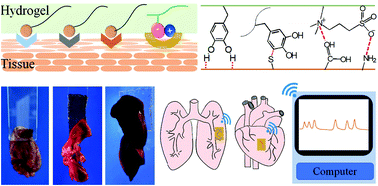
Mater. Horiz., 2020,7, 1872-1882
https://doi.org/10.1039/D0MH00361A
Nanostrip flexible microwave enzymatic biosensor for noninvasive epidermal glucose sensing
A nanostrip flexible microwave biosensor based on highly ordered nano-1D metamaterials is presented for epidermal trace glucose sensing.
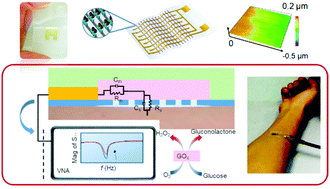
Nanoscale Horiz., 2020,5, 934-943
https://doi.org/10.1039/D0NH00098A
A new approach for an ultrasensitive tactile sensor covering an ultrawide pressure range based on the hierarchical pressure-peak effect
Flexible tactile sensors that imitate the skin tactile system have attracted extensive research interest due to their potential applications in medical diagnosis, intelligent robots and so on.
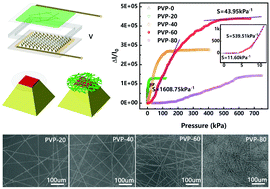
Nanoscale Horiz., 2020,5, 541-552
https://doi.org/10.1039/C9NH00671K
A simple yet effective AIE-based fluorescent nano-thermometer for temperature mapping in living cells using fluorescence lifetime imaging microscopy
A novel nano-thermometer composed of butter and AIE molecules can be used for intracellular temperature mapping using fluorescence lifetime imaging.
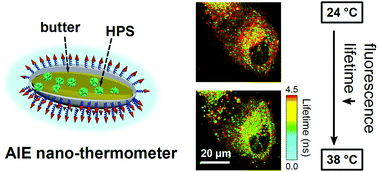
Nanoscale Horiz., 2020,5, 488-494
https://doi.org/10.1039/C9NH00693A
Metal-oxide surface-enhanced Raman biosensor template towards point-of-care EGFR detection and cancer diagnostics
Schematic illustration shows remarkable SERS activities of self-doped Q-structured TiOx with oxygen vacancies compared to the Q-structured TiO2.
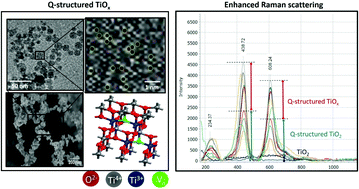
Nanoscale Horiz., 2020,5, 294-307
https://doi.org/10.1039/C9NH00590K
Novel electro-magnetophoretic separation method for the highly sensitive detection of analytes
We present a method to improve the detection limits of assays based on magnetic particles based on electro-magnetophoretic separation. It can be used with existing protocols to lower their detection limits by removing the excess of magnetic NP.
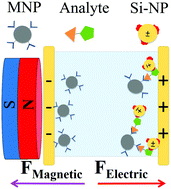
Nanoscale Horiz., 2020,5, 95-101
https://doi.org/10.1039/C9NH00279K
Disease-specific protein corona sensor arrays may have disease detection capacity
Protein corona sensor array technology identifies diseases through specific proteomics pattern recognition.
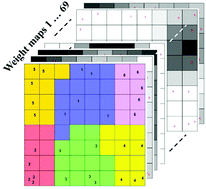
Nanoscale Horiz., 2019,4, 1063-1076
https://doi.org/10.1039/C9NH00097F
Nanoporous gold metamaterials for high sensitivity plasmonic sensing
A novel generation of portable SPR sensors with extreme sensitivity exceeding 15 000 nm per RIU is achieved with a system based on a nanoporous film.

Nanoscale Horiz., 2019,4, 1153-1157
https://doi.org/10.1039/C9NH00168A
Enhanced electrochemical biosensor and supercapacitor with 3D porous architectured graphene via salt impregnated inkjet maskless lithography
Advances in solution-phase graphene patterning has provided a facile route for rapid, low-cost and scalable manufacturing of electrochemical devices, even on flexible substrates.
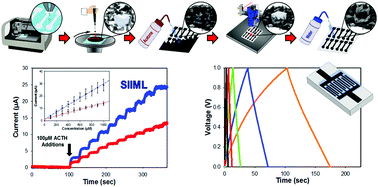
Nanoscale Horiz., 2019,4, 735-746
https://doi.org/10.1039/C8NH00377G
3D printing of ionic conductors for high-sensitivity wearable sensors
DLP 3D printed ionic hydrogels are designed as sensitivity-improved electrodes in a skin-like sensor.
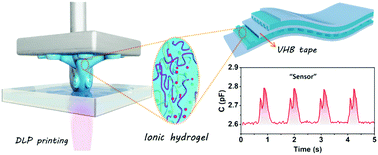
Mater. Horiz., 2019,6, 767-780
https://doi.org/10.1039/C8MH01398E
An intrinsically stretchable humidity sensor based on anti-drying, self-healing and transparent organohydrogels
A facile solvent-exchange strategy is devised to fabricate anti-drying, self-healing and transparent organohydrogels for stretchable humidity sensing applications.
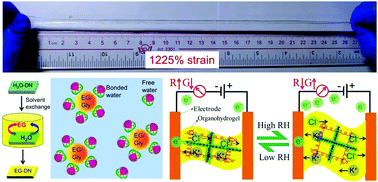
Mater. Horiz., 2019,6, 595-603
https://doi.org/10.1039/C8MH01160E
A two-photon AIEgen for simultaneous dual-color imaging of atherosclerotic plaques
A smart color-switchable AIEgen for two-photon dual-color bioimaging of mouse atherosclerotic plaques with single-excitation is reported.
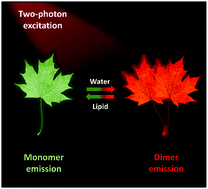
Mater. Horiz., 2019,6, 546-553
https://doi.org/10.1039/C8MH01293H
Adaptable polyionic elastomers with multiple sensations and entropy-driven actuations for prosthetic skins and neuromuscular systems
Polyionic elastomers were designed to address issues encountered by soft electronic and ionic conductors, and be applied to human–machine interactions.
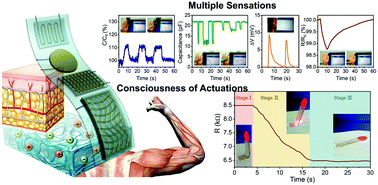
Mater. Horiz., 2019,6, 538-545
https://doi.org/10.1039/C8MH01157E
Upconversion-chameleon-driven DNA computing: the DNA-unlocked inner-filter-effect (DU-IFE) for operating a multicolor upconversion luminescent DNA logic library and Its biosensing application
Upconversion-chameleon-driven DNA computing: the DNA-Unlocked Inner-Filter-Effect (DU-IFE) between upconversion nanoparticles (UCNPs) and OxTMB is reported and applied to operate the first RGB UC luminescent DNA logic library and biosensing.
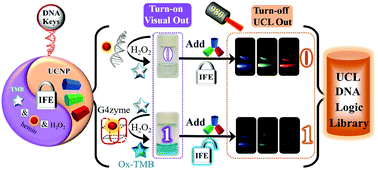
Mater. Horiz., 2019,6, 375-384
https://doi.org/10.1039/C8MH01151F
A location- and sharpness-specific tactile electronic skin based on staircase-like nanowire patches
A new stretchable tactile electronic skin sensor that could sense touch, location and sharpness is presented.
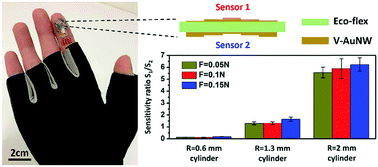
Nanoscale Horiz., 2018,3, 640-647
https://doi.org/10.1039/C8NH00125A
An all-solid-state biocompatible ion-to-electron transducer for bioelectronics
The first all solid state organic electrochemical transistor based upon the skin pigment melanin.
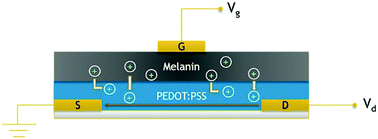
Mater. Horiz., 2018,5, 256-263
https://doi.org/10.1039/C7MH00831G
Molecular antenna tailored organic thin-film transistors for sensing application
By tailoring the neighboring-conductive-channel organic layer using a plasma-assisted-interfacial-grafting method, we introduced a molecular antenna on the surface of organic transistors to enable direct interaction between the semiconductors in the conductive channel and the target analytes in solution.
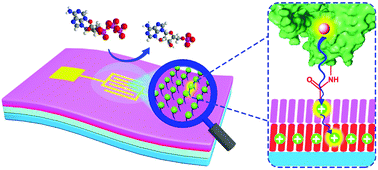
Mater. Horiz., 2018,5, 240-247
https://doi.org/10.1039/C7MH00887B
Janus DNA orthogonal adsorption of graphene oxide and metal oxide nanoparticles enabling stable sensing in serum
Sensing DNA in a complex sample matrix using the adsorption difference between DNA and proteins on nanomaterials.
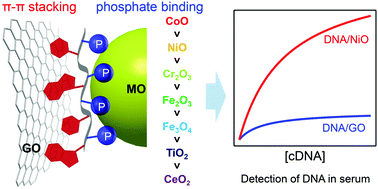
Mater. Horiz., 2018,5, 65-69
https://doi.org/10.1039/C7MH00804J
Catalytic assembly of DNA nanostructures on a nanoporous gold array as 3D architectures for label-free telomerase activity sensing
SERS detection of 3D nanoassemblies on a nanoporous gold array (NPGA), exploring the synergy of catalytic multiplication and plasmon signal intensification.
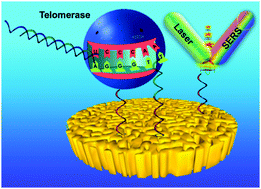
Nanoscale Horiz., 2017,2, 217-224
https://doi.org/10.1039/C7NH00042A
About this collection
Guest Edited by Nanoscale Horizons and Materials Horizons Community Board members Zhiyuan Liu, Shenzhen Institutes of Advanced Technology, Chinese Academy of Sciences, Gift Mehlana, Midlands State University, Zimbabwe, and Arun Richard Chandrasekaran, The RNA Institute, University at Albany, USA.
Development of sensing technologies has been one of the prime focus of recent research. In this area of research, scientists have developed different types of materials for use in biosensing, analyzed different biological targets and specimens, and combined nanoscale developments into the macroscopic world for real life applications. In this collection, we have compiled a list of articles that discuss these developments in the area of biosensing. We hope it will provide some insight to recent developments in biosensing and adaptability of ongoing lab-based research for real life applications.